Pink grape varieties: an overview of the best table, versatile and wine varieties
Perhaps, it is the pink varieties that are most popular among grape lovers, because such beautiful bushes will only decorate the garden, besides, their presentation is very attractive.
Further you can learn about the best and most popular pink grape varieties, their taste, brief characteristics, distinctive features and cultivation characteristics.
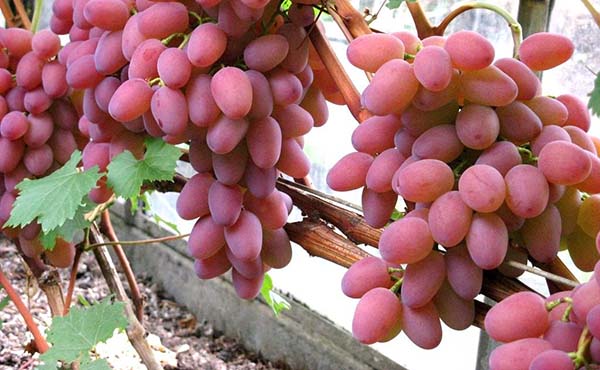
Content
- 1 The best pink table grapes: top 20 most popular varieties (alphabetically)
- 1.1 Azalea
- 1.2 Anyuta
- 1.3 Arched (Friendship pink, Colored)
- 1.4 Victor
- 1.5 Early gourmet (Novocherkassky Red 1-12)
- 1.6 Dubovsky pink
- 1.7 Kishmish Veles (Veles)
- 1.8 Radiant kishmish
- 1.9 Libya
- 1.10 Original
- 1.11 Transformation
- 1.12 Pink haze
- 1.13 Rumba
- 1.14 Russian early
- 1.15 Sensation
- 1.16 Somerset Seedlis
- 1.17 Sofia
- 1.18 Taifi pink (Taifi kizyl, Toipi kizyl, Toifi antimony, Gissori)
- 1.19 Anniversary of Novocherkassk
- 1.20 Julian
- 1.21 Other pink varieties
- 2 The best rose varieties of universal and wine grapes
The best pink table grapes: top 20 most popular varieties (alphabetically)
This group contains grape varieties in which the color of the berries varies from pale pink to bright red with crimson (but not dark red - these are already black or blue). In addition, the color of the fruit can change as it ripens. In most cases, it all depends on the weather conditions: in extreme heat, without changes in day and night temperatures, the berries are almost not colored, the maximum they have is a very unsaturated pink color.
Azalea
The variety is obtained by a complex crossing of Nadezhda Aksayskaya, as well as a mixture of pollen from Delight red and Taifi resistant. Amateur selection Kapelyushny V.U.
The bushes are medium-sized.
Forms large clusters of medium-friable structure, which are distinguished by a short peduncle. The average weight of one grape cluster is 700 grams (maximum 1-1.2 kg).
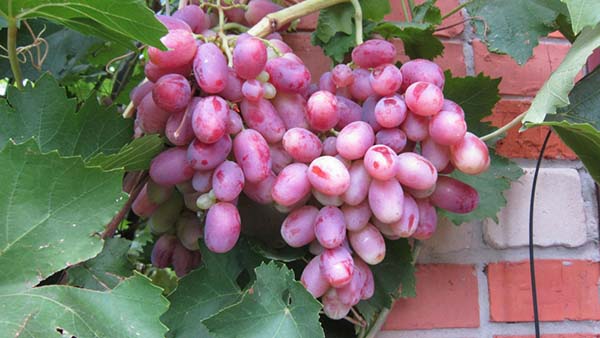
Fruits of uniform light pink color. Azalea berries are large, 34 mm long, 25 mm wide, reminiscent of an oval, each weighing 10-14 g. The pulp of the fruit is juicy, fleshy, with a thin skin, which is not noticeable when consumed.
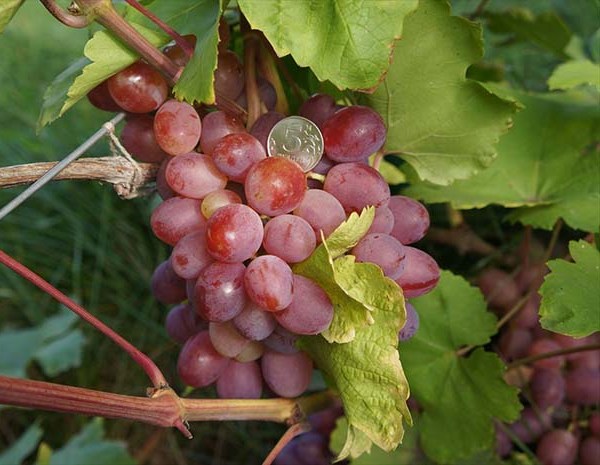
Characteristic features of Azalea:
- ripening period - 105-120 days (very early or very early);
- sugar accumulation - 21-23%;
- acidity - 5-6 g / l;
- eye load - 25-35;
- it is optimal to do an average pruning of 6-8 eyes;
- frost resistance up to -25 degrees.
Advantages:
- It has bisexual flowers, which gives stable pollination.
- High productivity.
- Not prone to peas.
- Not damaged in transit (excellent transportability).
- High resistance to mildew, gray rot and powdery mildew (2-2.5 points).
- High survival rate of cuttings.
Disadvantages:
- Yield adjustment required.
- Strong rootstocks are required.
Anyuta
A hybrid form of culture, obtained on the basis of Talisman (Kesha-1) and Radiant Kishmish. Amateur selection V.N. Krainova.
A variety of high vigor.
Anyuta forms large brushes weighing 700-800 grams (up to a maximum of 1.5 kg) of medium friability.
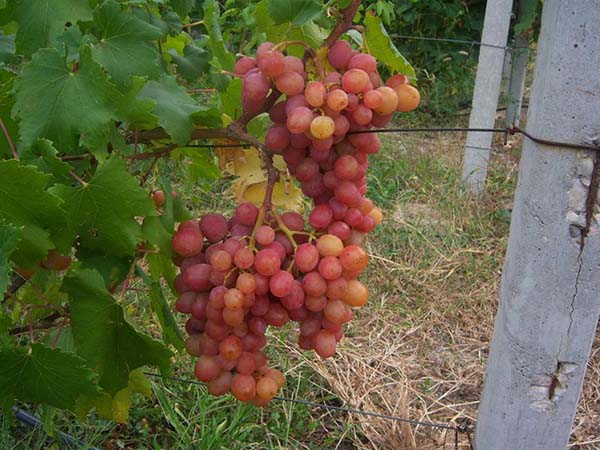
The fruit should be dark pink in color. Berries are oval, large, weighing 10-15 g (sometimes up to 20 g). The flesh is fleshy and the rind is firm. Anyuta grapes are characterized by an unobtrusive aroma of nutmeg.
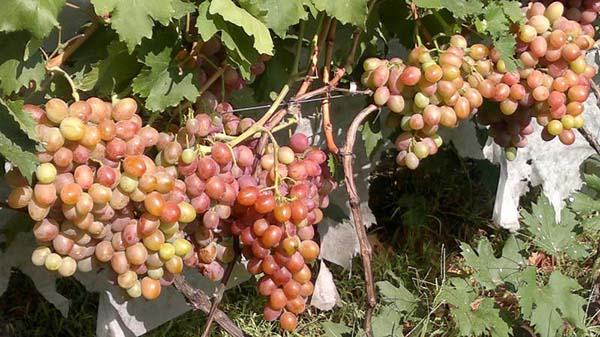
Characteristic features of Anyuta:
- ripening period - 140 days (medium or medium late);
- sugar accumulation - 18-50%;
- acid content - 5-7 g / l;
- fruiting rate - 1.3;
- eye load - 30-50;
- recommended pruning for 8-10 eyes;
- frost resistance up to -22 ..- 23 degrees.
Advantages:
- It has bisexual flowers, which gives stable pollination.
- The fruits do not crack even when the soil is waterlogged.
- Not prone to peas.
- Wasps are not damaged.
- Compatible with any rootstock.
- Good rooting of cuttings.
- Relative (average) resistance to mildew and oidium (3-3.5 points).
- Good vine maturation.
- Not damaged in transit.
Disadvantages:
- It is necessary to adjust the load, because prone to overload.
- There is often uneven ripening and color of the berry.
Arched (Friendship pink, Colored)
Obtained by crossing presumably the varieties Intervitis Magaracha and Druzhba. Selections VNIIViV named after Ya. Potapenko (Russia).
Bushes are vigorous. The flower is bisexual.
The bunches are large, 400-600 g, cylindrical-conical, moderately dense and dense, well-formed and even in weight.
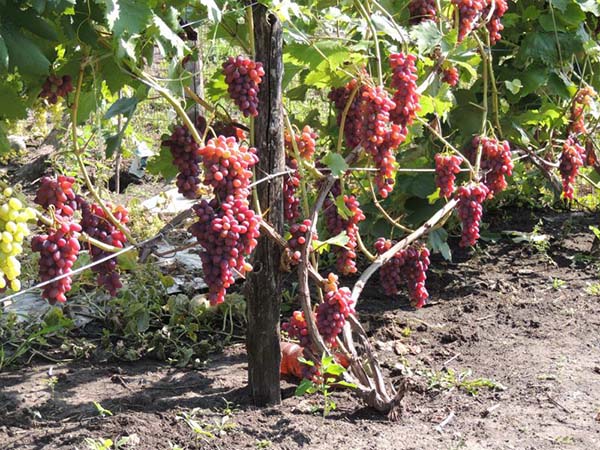
Fruits are pink, in the sun they acquire a red tint. The berries are large, 17-18 by 24-25 mm in size, oval-nipple-shaped. Harmonious taste, with dense and fleshy-juicy pulp, the skin is dense (eaten), therefore crunches. The seeds are quite large.

Characteristics of the Arochny variety:
- ripening period - 115-120 days (early);
- sugar content - 16-18%;
- acidity - 4-5 g / l;
- the percentage of fruitful shoots - 65-80%;
- the number of clusters per shoot - 1.5-1.8;
- load on the bush - 30-40 eyes;
- pruning vines - 6-8 eyes;
The fruitfulness of the eyes at the base of the shoots is high, so you can also carry out a short pruning of 3-4 eyes.
- frost resistance up to -25 degrees.
Advantages:
- Good tasting score (7.7 points).
- Medium resistant to mildew (3.5 points), gray rot.
- No peas.
- No normalization required.
- Shoots ripen very well.
- Cuttings root well.
- The compatibility with rootstocks and varieties is good.
- The yield is high and stable.
- Bunches can hang on bushes for a long time without losing marketability.
- Transportability and marketability are high.
The variety is responsive to increased doses of organic and mineral fertilizers.
Disadvantages:
- Weakly resistant to powdery mildew.
- They love wasps.
- For some, it has a floral / fruit flavor, and for others, herbs.
- Sometimes there are very small berries and too large seeds.
Victor
Bred by amateur winegrower V.N.Krainov (Transfiguration and Jubilee of Novocherkassk are also his varieties).
The variety is medium or vigorous.
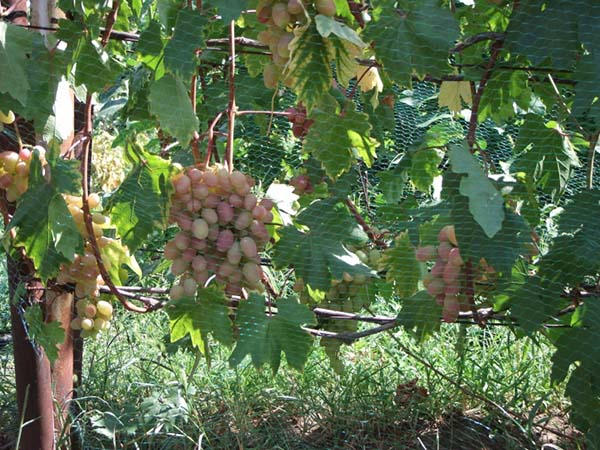
Grape clusters are large (up to 2 kg) or medium in size, weighing 500-1000 grams, medium density.
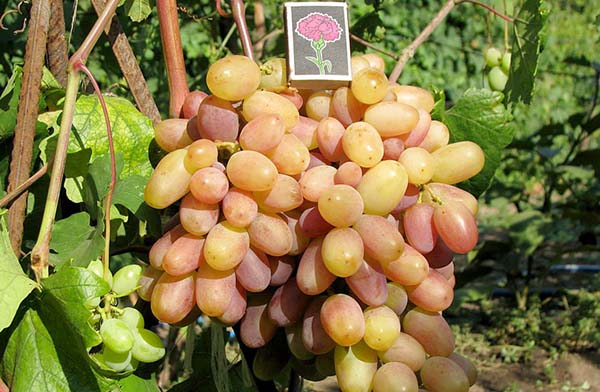
The color changes as the fruit ripens from pink-amber to red-lilac. Fruits in the form of an elongated oval with a pointed end. Very large, their weight is about 9-15 g (maximum up to 20 grams), and their length is about 50 mm. The taste is pleasant, the pulp is fleshy and juicy, with an average density. Victor has a thin edible rind.
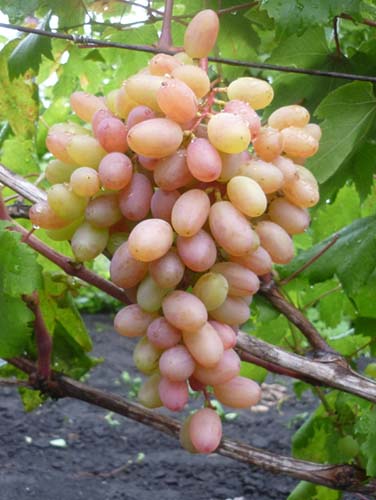
Characteristics of the Victor variety:
- ripening period - 100-110 days (very early or very early);
- sugar content - up to 17 g / l;
- acid content - 8 g / l;
- the maximum load of the eyes is 30-40;
- trimmed into 8-10 eyes;
- frost resistance up to -23 degrees.
Advantages:
- Bisexual flowers.
- Yield stability.
- Not prone to peas.
- Shoots ripen well.
- Excellent presentation.
- Good resistance to common fungal diseases (mildew, powdery mildew, gray mold).
By the way! Victor forms many stepchildren, which makes it possible to re-harvest on new shoots.
Disadvantages:
- Very early flowering period, which increases the likelihood of damage to inflorescences in the event of late spring frosts.
- Attractive to wasps.
- It is necessary to graft on vigorous rootstocks.
Early gourmet (Novocherkassky Red 1-12)
A variety of amateur breeding Krainova V.N., obtained by crossing the varieties Talisman and Kishmish radiant.
Bushes above average vigor. The flower is functional and feminine.
The bunch is cylindro-conical, medium density, large, weighing 500-900 g (individual up to 1.2-1.3 kg).
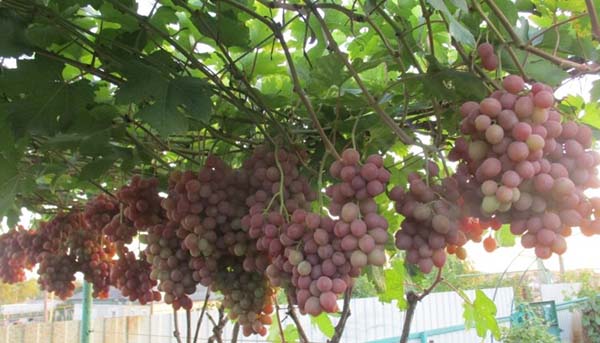
The berry is pink, oval, large, weighing 7-9 g. The taste of nutmeg is very bright, the flesh is fleshy and juicy. Eatable peel.
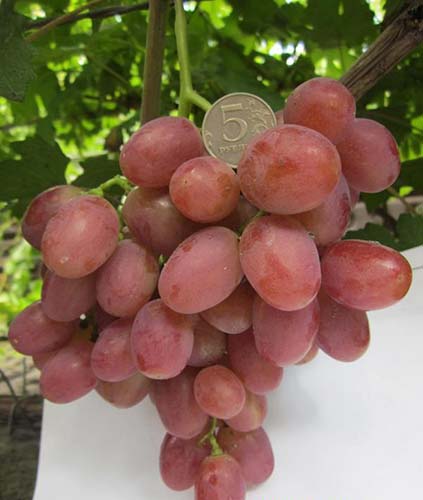
Characteristics of the early Gourmet variety:
- ripening period - 115-125 days (early);
- recommended load with eyes - 30-35;
- pruning vines - 6-8 eyes;
- frost resistance up to -23 degrees.
Advantages:
- Shoots ripen well.
- Wasp is hardly damaged.
- High transportability and marketability.
- Increased resistance to mildew and gray mold, medium to powdery mildew.
Disadvantages:
- Requires rationing of the load of fruits and shoots (otherwise the taste will deteriorate).
Dubovsky pink
Obtained by crossing the varieties Red Delight and Yubiley Novocherkassk. Amateur selection Gusev S.E.
The growth force of the bushes is very high. The flower is bisexual.
The bunches are large and very large, weighing 500-800 g (individual up to 1200-1500 g), conical or branched, elongated, drooping, loose, less often very loose or medium density.
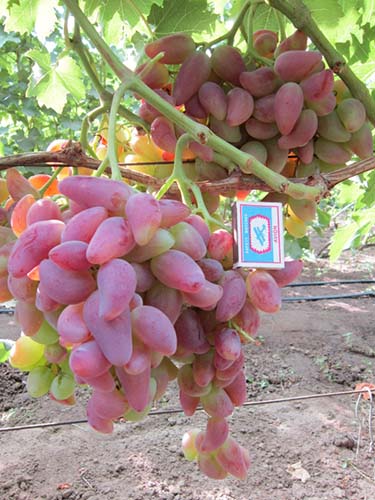
The berries are dark pink, very large, elongated-oval with a pointed tip, weighing 14-16 g. The pulp is dense, fleshy-juicy, the taste is harmonious. The peel is of medium thickness and density.
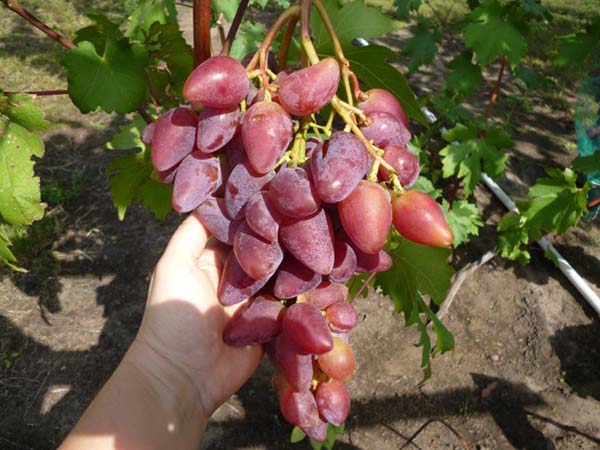
Characteristics of the variety Dubovsky pink:
- ripening period - early;
- sugar content of juice - 16-18 g / 100 cm3;
- acidity - 4-6 g / dm3;
- pruning vines for fruiting - 6-8 eyes (average);
- frost resistance up to -24 degrees.
Advantages:
- High tasting score (9.3 points).
- Transportability is good.
- The yield is high.
Advice! It is recommended to use pinching to improve the presentation of the bunches.
Disadvantages:
- Ripening of shoots is satisfactory.
- Requires rationing of bushes with inflorescences.
- Poorly gaining color in the south.
Kishmish Veles (Veles)
Seedless hybrid form of culture, bred by crossing the varieties Sofia and Rusbol. Selections V.V. Zagorulko (Ukraine).
Note! Veles is almost identical to Radiant Kishmish (in terms of yield, partly in the taste of pulp, color of berries), the whole difference is in the ripening period.
Differs in vigorous bushes.
Bunches at Kishmish Veles are formed in the form of a wide cone, branched, with an average level of density. Grape clusters reach a mass of 900-1700 g, and in some cases - up to 3 kg.
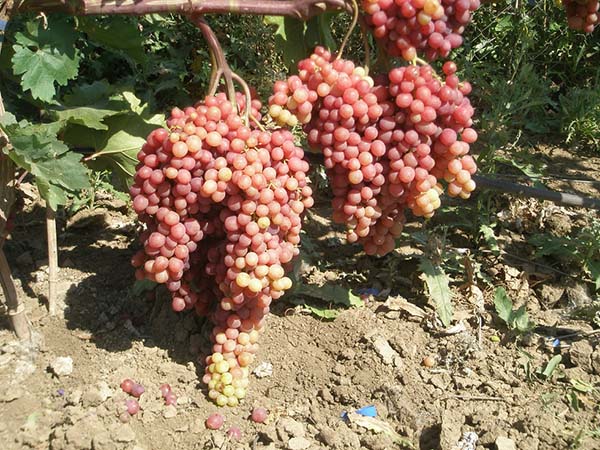
The fruits are pink with an amber tint. Berries are oval, weighing 4-5 g. Sweet taste, with an unobtrusive nutmeg aroma. The pulp is firm and crispy. The rind is thin, slightly palpable when consumed.
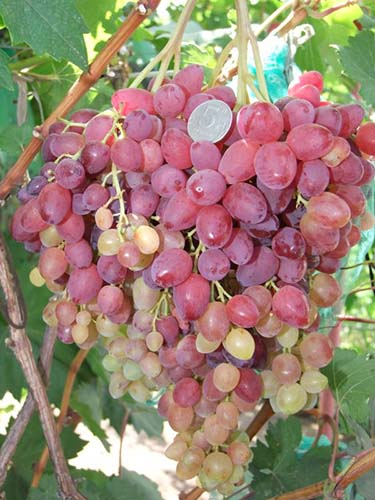
Characteristics of the Veles variety:
- ripening period - 95-105 days (very early);
- requires medium pruning of up to 6 eyes, but can be cut short.
- frost resistance up to -21 degrees.
Benefits:
- High yield, just gigantic brushes.
- Flowers are bisexual.
- Shoots ripen well.
- Suitable for long-term storage.
- Average resistance to mildew and powdery mildew (3.5 points).
There is also a stepchild's harvest on the bushes.
Disadvantages:
- After the rains, some of the berries crack.
- The bunches must be shortened, otherwise the color of the bunch is uneven.
- Often affected by gray rot.
Radiant kishmish
The variety is seedless, obtained on the basis of crossing the varieties Cardinal and Kishmish pink. Breeding "Vierul" (Moldova).
Bushes are medium and vigorous.
Leaves with a light green shade of heart-shaped, have elongated petioles. The bunches of Radiant Kishmish are medium (400-600 grams), as well as large ones, having a cylindrical-conical shape with an extension at the ends, up to 40 cm long and a maximum weight of up to 1-1.5 kg. The structure of the bunch is often medium friable with lobes.
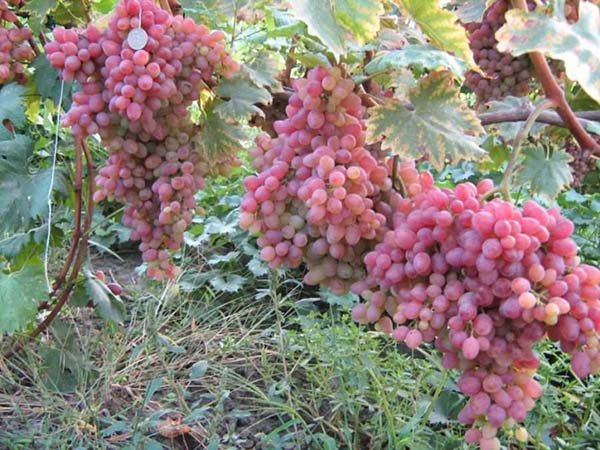
The berries initially have a golden-pink hue, but as they ripen, they acquire a red-pink color. The length of the fruits of Radiant Kishmish is 22-25 mm, the height is 17-22 m, and the weight is 2.5-4 g. Their dense flesh is characterized by a harmonious slightly nutmeg taste and aroma (it has a nightshade flavor in the background). The skin is firm, slightly palpable when consumed.
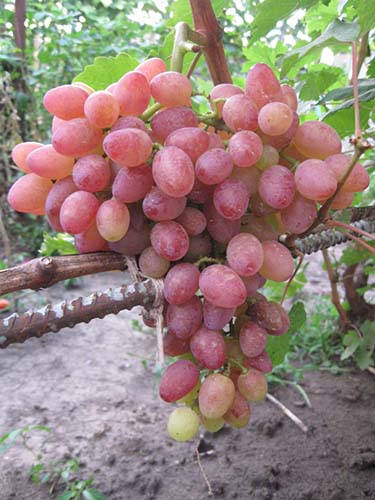
Characteristic differences of radiant kishmish:
- ripening period - 125-130 days (early-middle);
- sugar accumulation - 17-21%;
- acid content - 6-7 g / l;
- number of fruitful shoots — 50-70%;
- the number of clusters per shoot - 1.3-1.6;
- the load on the bush when pruning is 30-40 eyes;
- necessary trimming - 10-12 eyes;
- frost resistance up to -21 ... -22 degrees.
Benefits:
- Bisexual flower type.
- High taste indicators.
- High marketability.
- Not damaged in transit.
- Good vine maturation.
- Not prone to peas.
- Suitable for long-term storage.
By the way! Responds very well to gibberellin treatment.
Disadvantages:
- Low resistance to fungal diseases.
- Needs rationing of the yield and constant formation of the bush.
- Demanding to agricultural technology.
Libya
The hybrid was bred by crossing based on the main qualities of the Flamingo and Arcadia varieties. Breeding "Magarach" (Ukraine), V.V. Zagorulko.
Forms vigorous plants.
The bunches of Libya are large, 25 cm or more long, cylindrical, moderately loose.
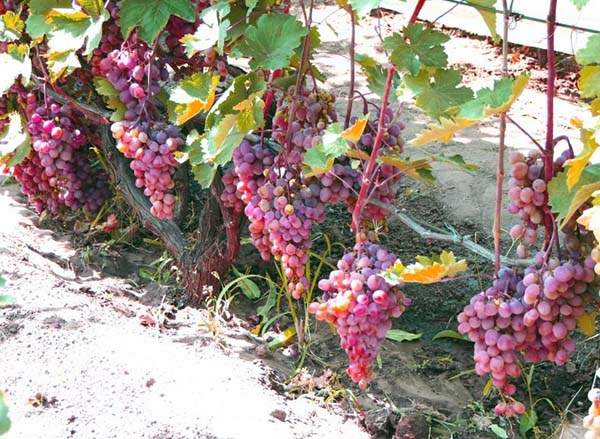
It has an uneven color - from light pink to saturated when the bunch ripens. The size of the berries is 28 mm by 18-20 mm (oval or ovoid), weight is 10-15 grams. The pulp is fleshy and juicy, the rind is not felt during use. Each berry contains no more than 1-3 seeds, which are easily separated. Libya is characterized by a pleasant taste with a nutmeg hue. The aroma lasts for 30 days during storage.
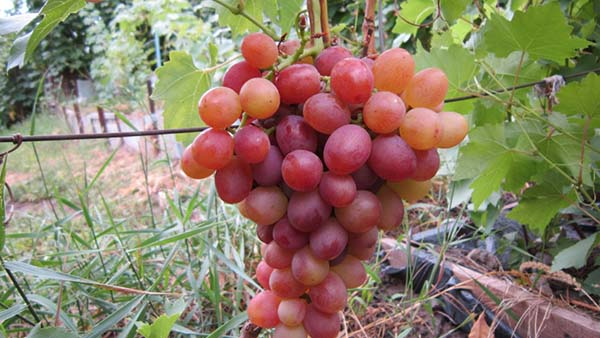
Characteristics of the variety Libya:
- ripening period - 105-110 days (very early);
- sugar accumulation - 20-25%;
- acidity - 6-7 g / l;
- the ratio of fruiting shoots is 70-80%.
- pruning shoots is recommended for 2-6 eyes.
- frost resistance up to -21 degrees.
Benefits:
- Stable yield.
- The flowers on the plant are bisexual, which guarantees a stable ovary.
- Shoots ripen perfectly.
- Excellent transportability.
- Good marketability.
Important! Saplings grow better on their own roots than on a scion.
Minuses:
- Very average resistance to powdery mildew (3.5-4 points).
- Uneven color of berries.
- Poor vine ripening at the slightest overload.
Original
The variety is obtained by crossing the combination of the qualities of the Datie de Saint-Valier variety and the Damascus rose. Selection IV&V them. V.E. Tairova (Ukraine).
Forms vigorous plants with a high degree of formation of stepchildren.
Beautiful clusters of conical grapes weighing 400-600 g with an average density.

The color is white-pink and pink (in the sun). The size of the fruits is large - 30 by 22 mm, weight - 6-9 grams, the shape is very unusual - nipple-like with a pointed end and interception. Taste properties are simple, but harmonious, juicy. The skin is firm and palpable when consumed. There are only 1-2 seeds in the berry.
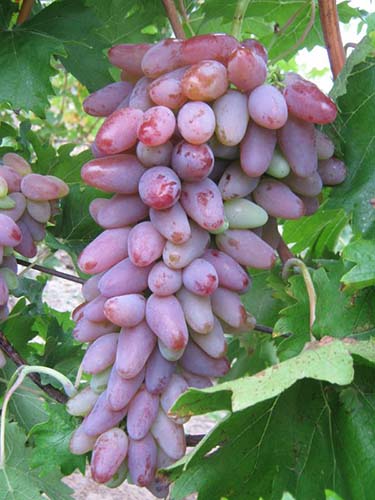
Characteristics of the Original variety:
- ripening period - 135-145 days (average);
- sugar accumulation - 19-21%;
- acid ratio - 5-6 g / l;
- the ratio of fertile vines - 65-80%;
- the coefficient of bunches is 1.6-1.7;
- eye load - 45-60;
- pruning is recommended for 8-12 eyes;
- frost resistance up to -21 degrees.
Note! Successful cultivation requires a high level of agricultural technology, as well as powerful shaping with a large stock of old wood.
Benefits:
- Very decorative (unusual) appearance.
- Ripening of shoots is good.
- High resistance to grape diseases: powdery mildew, mildew and gray rot.
- Tolerant to phylloxera.
- Wasps are not damaged.
- It can hang on a bush until frost without losing its taste.
Disadvantages:
- The yield is average.
- Average rooting rate of cuttings.
- Flowers are unisexual, so they need pollinators.
- Prone to peas.
- There is a lot of stepchild's harvest that does not ripen.
- Low transportability due to poor attachment of the berry to the stalk.
- The pulp is not firm.
- Thick skin.
Interesting! The original can be called a grape for the lazy, because practically does not require treatments for the main fungal diseases, so to speak, planted and harvest (albeit not large, simple in taste, but quite pleasant and especially pleasing to the eye).
Transformation
A hybrid of grapes obtained as a result of amateur selection by V. Krainov.
Vigorous plants with a high degree of formation of stepsons.
Forms mainly shapeless and conical clusters weighing 700-1500 grams.
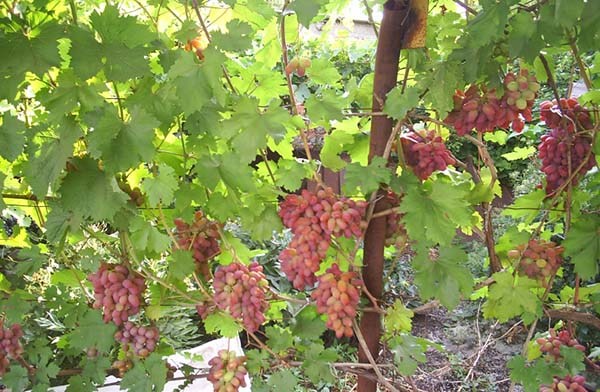
The color of the berries is from intense pink to red, more often the color is amber-pink, of an uneven color. Fruits are large, oval-elongated, weight reaches 10-14 g. Taste qualities are harmonious. The flesh of the Transfiguration is fleshy, the skin is medium dense, but not perceptible when consumed.
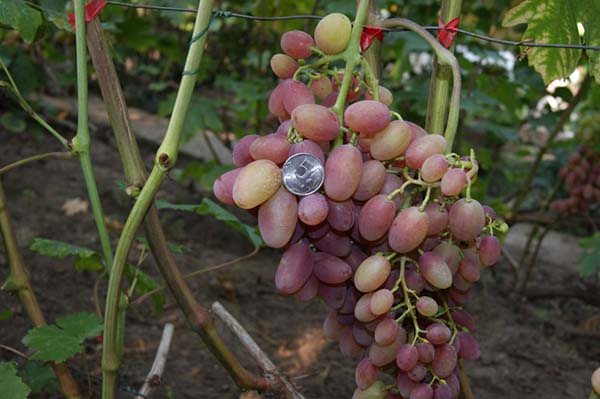
Characteristics of the Transfiguration variety:
- ripening period - 105-110 days (very early);
- sugar content - 17-19%;
- acid ratio - 6-7 g / l;
- the load of the bush with shoots - up to 30-35;
- optimal pruning by 6-8 eyes, but a good result is also obtained by pruning by 2-4 eyes;
- frost resistance up to -23 degrees.
Benefits:
- Has bisexual flowers.
- Good resistance to gray mold.
- Very high transportability and marketability.
- There is a possibility of re-harvesting on stepchildren.
- No peas.
- Good maturation of the vine.
Disadvantages:
- Very average resistance to common fungal diseases: mildew and oidium (3.5-4 points).
- Attracts wasps.
- Load rationing is required.
Important! Does not tolerate close proximity to trees and shrubs.
Pink haze
A hybrid form of grapes, obtained by crossing the varieties Talisman and Kishmish radiant, bred by V.N. Krainova.
Bushes of great vigor. The flower is bisexual.
The bunches are cylindrical-conical, large, of medium density, the average weight of the bunch is 700 g (individual up to 1.5 kg).
The berries are white with a slight blurry pink blush, oval, large, up to 32-34 by 26-28 mm in size, the average berry weight is 12-14 g. The flesh is fleshy, the skin is practically not felt. The taste is harmonious, pleasant and varietal, with a noticeable sourness.

Characteristics of the Pink Haze variety:
- ripening period - 115-125 days (early);
- the percentage of fruitful shoots - 75-85%;
- fruiting coefficient - 1.2-1.4;
- plant load with eyes - 30-35.
- pruning fruiting vines - 8-10 eyes (long).
- sugar content - 16.8-18.5 g / 100 cm3;
- acidity - 5-7 g / dm3;
- frost resistance up to -23 degrees.
Advantages:
- The ripening of the vine is high.
- The cuttings root very well.
- Rootstock compatibility is good.
- Not prone to peas.
- Transportability and commercial qualities are high.
- Increased resistance to mildew and gray mold.
Disadvantages:
- Average resistance to powdery mildew.
- Sometimes it is affected by wasps.
Rumba
Bred by crossing the Red and Charrel varieties. Amateur selection of Kapelyushny V.U.
Bushes of medium vigor. The flower is bisexual.
The bunches are large, cylindrical-conical, loose or of medium density, weighing 470-900 g or more, measuring 20-30 cm by 10-12 cm.
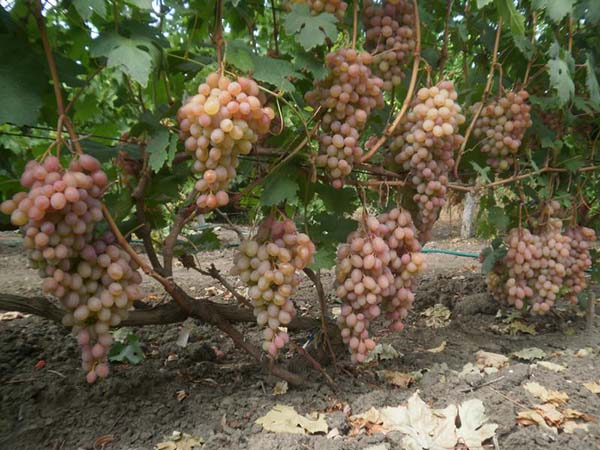
The berries are pink (bright red when fully ripe), very beautiful and large, 32 by 24 mm in size, nipple-shaped, weighing 8-10 g or more. The pulp is fleshy and juicy, sweet, with a pleasant aroma.
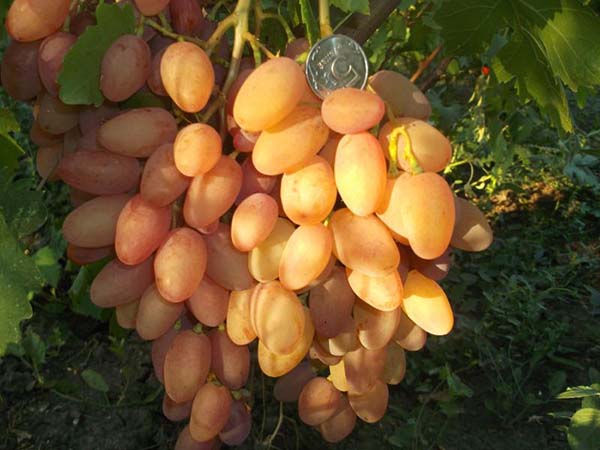
Characteristics of the Rumba variety:
- ripening period - 85-95 days (very early), according to other sources - 95-115 days (very early);
- load on the bush - 40-45 eyes;
- trimming - for 8-10 eyes;
- frost resistance up to -25 degrees.
Advantages:
- The yield is high and stable.
- It has very good commercial qualities and appearance.
- Transportability at altitude.
- Rootstock compatibility is good.
- The cuttings root very well.
- No peas.
- High resistance to mildew, oidium, gray rot (2 points).
Prone to the formation of a second stepchild's harvest.
Disadvantages:
- Some people think that the taste is too rustic (only sweet, without notes of anything).
Russian early
Obtained by crossing the varieties Shasla Severnaya and Michurinets. Breeding VNIIViV them. ME AND. Potapenko (Russia).
Bushes are medium and vigorous. The flowers are bisexual.
The clusters are medium, 200-400 g, conical, of moderate density and loose.
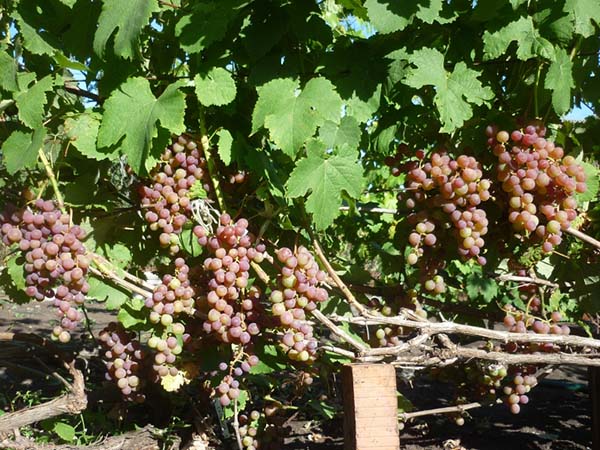
Fruits are dark pink. Berries are medium and large (medium size - 21 by 23 mm), round, weighing 3-5 g. The flesh is crispy, sweet, simple but harmonious taste, without any aroma.
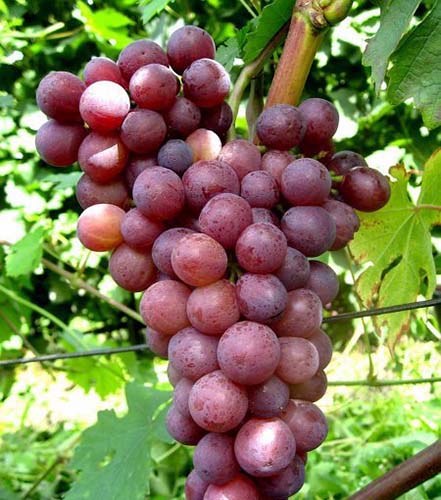
Recommended for growing in film and glass greenhouses.
Characteristics of the Russian early variety:
- ripening period - 105-115 days (very early);
- sugar content - 17-21%;
- acidity - 6-7 g / l;
- frost resistance up to -23 degrees.
Advantages:
- relatively resistant to mildew, gray rot, powdery mildew.
- shoots ripen well.
- very productive and not afraid of overload.
On a fruitful shoot, often 2-3 inflorescences.
- transportability and marketability are good.
Disadvantages:
- Wasps, ants, copperhead beetles and even butterflies often attack.
- Taste without aroma or aftertaste of anything, just very sweet.
Sensation
A hybrid crossed on the basis of the Talisman and Rizamat varieties. Breeding Kapelyushny V.U.
It is characterized by high vigor of shoot growth.
Possesses high decorative and taste qualities. The sensation forms clusters of large size, conical shape, weighing 700-1500 g. Their structure can be medium-dense or loose.
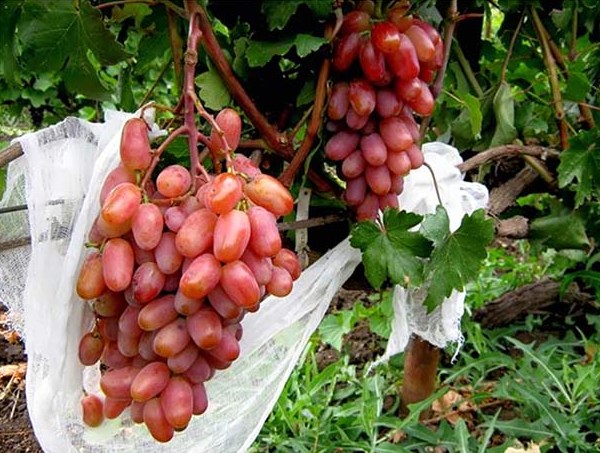
Berries of a yellow-pink hue with crimson. Large fruits have an unusual finger shape, the weight of one berry reaches 16-22 g. The taste is harmonious, and when ripe, nutmeg notes are added. The flesh of the fruit is juicy and fleshy, with a thin skin, imperceptible during use.
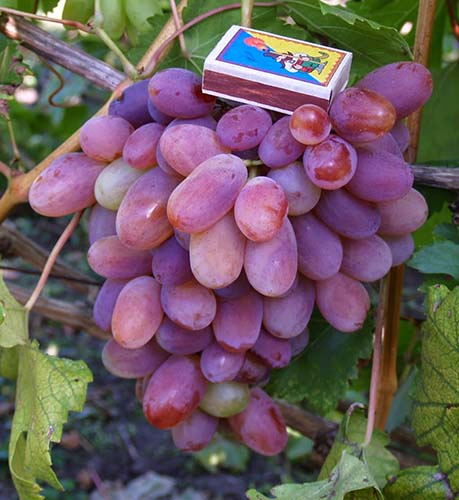
Characteristics of the variety Sensation:
- ripening period - up to 100 days (very early).
- optimal load - 40-45 eyes;
- pruning vines for 8-10 eyes;
- frost resistance up to -24 degrees.
Benefits:
- Differs in bisexual flowers, which guarantees pollination under all conditions.
- High productivity.
- Ripening of shoots is good.
- No peas.
- Wasps are practically not damaged.
- High resistance to major diseases: mildew, oidium and gray rot (2.0-2.5 points).
- High percentage of rooting cuttings.
- Marketability and transportability are high.
Minuses:
- The load on the bush must be normalized.
- Often there are problems with the color of the berry (very transparent).
Somerset Seedlis
One of the best seedless varieties for northern viticulture created in the USA.
Bushes of medium to strong growth.
Bunches are small and medium (weighing 100-200 g). Dense and cylindrical.
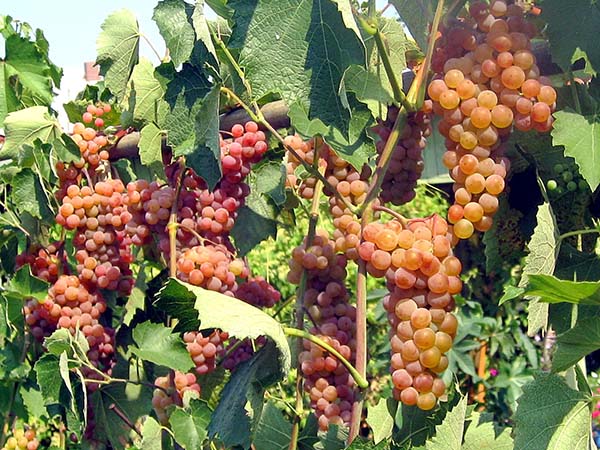
The berries are pink, small, round. The taste is pleasant, from strawberry-silk to caramel. Medium-density peel, firm, edible. Rudiments are sometimes found in fruits.
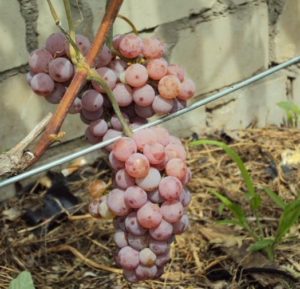
Somerset Seedles Variety Characteristics:
- ripening period - very early;
- any trimming is allowed (short, medium, long);
- frost resistance up to - 30-34 degrees.
- Very high frost resistance.
- Great taste.
- Excellent vine maturation.
- Comprehensive disease resistance.
- The yield is average.
- Very small clusters, or rather clusters.
Sofia
A hybrid form of grapes obtained by crossing Arcadia and Kishmish Luchisty, selection by V.V. Zagorulko (Ukraine).
Bushes are vigorous. The flower is functionally feminine.
The best pollinator for Sofia is Arcadia.
The bunches are large and very large, dense, weighing from 1 kg to 3 kg.
The berries are pink in color, large and very large (28-36 mm long, 20-21 mm wide), resembling the egg-shaped Arcadia variety. The skin of the berry is not felt when eaten. The pulp is fleshy and juicy, with a nutmeg aroma. The largest berries contain 1-2 seeds.
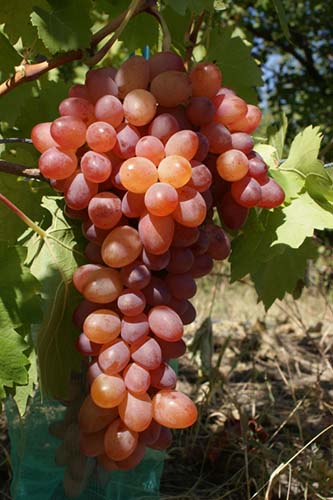
Characteristics of the Sofia variety:
- ripening period -110-115 days (very early);
- trimming - 4-8 eyes;
- frost resistance up to - 21 degrees.
Excessive nitrogen fertilization should be avoided.
Advantages:
- Very beautiful (marketable) type of bunches.
- Amazing taste.
- As a rule, the shoots ripen evenly and completely.
Disadvantages:
- Very average resistance to mildew and oidium (3.5-4 points).
- Prone to cross-pollination.
- The bunches are dense, therefore they require thinning of the berries.
- There are peas.
- May crack.
Taifi pink (Taifi kizyl, Toipi kizyl, Toifi antimony, Gissori)
Belongs to the group of oriental (Asian) grape varieties.
Bushes are vigorous. The flower is bisexual.
The bunch is large or very large (27 cm long, 19 cm wide), conical or cylindro-conical, with very developed lateral lobes, loose. The stem of the cluster is of medium length or long (3-7 cm), lignified at the base. The average weight of a bunch is 675 g, the maximum (in Uzbekistan) is 6.5 kg.
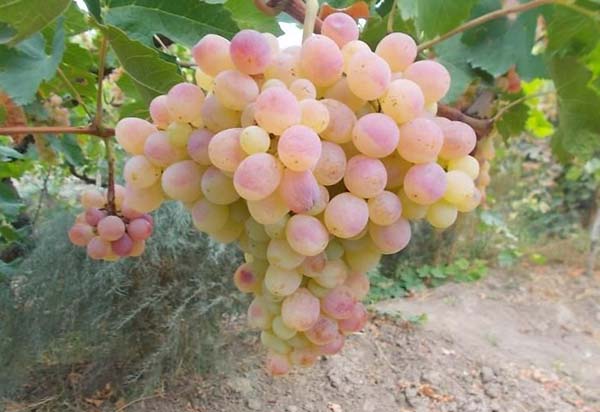 When fully ripe, berries are dark pink with a purple tint (initially yellow with purple spots), covered with a medium waxy bloom and dots. The berry is very large (27 mm long, 19 mm wide), oblong-oval or cylindrical, with a beveled top. Sometimes there is a shallow groove at the top of the grape. The average weight of berries is 4-8 g. The skin is thick, bright red on the inside. The pulp is dense, fleshy-crunchy, pleasant taste. The juice is colorless. The berry contains 2-3 medium-sized seeds.
When fully ripe, berries are dark pink with a purple tint (initially yellow with purple spots), covered with a medium waxy bloom and dots. The berry is very large (27 mm long, 19 mm wide), oblong-oval or cylindrical, with a beveled top. Sometimes there is a shallow groove at the top of the grape. The average weight of berries is 4-8 g. The skin is thick, bright red on the inside. The pulp is dense, fleshy-crunchy, pleasant taste. The juice is colorless. The berry contains 2-3 medium-sized seeds.
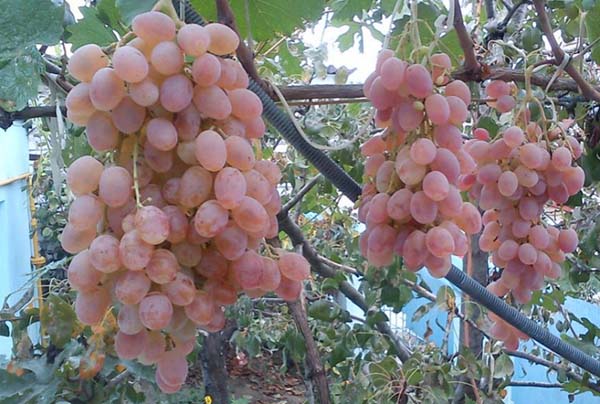
Characteristics of the Taifi pink variety:
- ripening period - 167 days (late);
- sugar content - 17.2 g / 100 ml;
- acidity - 6.5 g / l;
- the percentage of fruitful shoots - 25.6%;
- the average number of clusters on a developed shoot is 0.1, on a fruitful one - 0.7.
- frost resistance up to -15 ..- 18 degrees.
The grape variety requires formation on a high stem with a large supply of perennial wood, long pruning of shoots.
Advantages:
- Good tasting score (7.4 points), and high in Central Asia (9 points).
- It is relatively salt-tolerant and drought-tolerant.
- Hangs on the bush for a long time without problems.
- Pulls a heavy load.
- Well stored and transported.
Disadvantages:
- Weakly resistant to mildew and oidium.
- It is damaged by a spider mite.
- Not very hardy.
Anniversary of Novocherkassk
A hybrid of complex interspecific selection by V.N. Krainova.
It is distinguished by a vigorous bush both on a grafted crop and on a self-rooted one.
Forms impressive tapered brushes of medium density, the mass of which varies from 700-1700 g. But it can reach 3000 g, subject to all the rules of care.
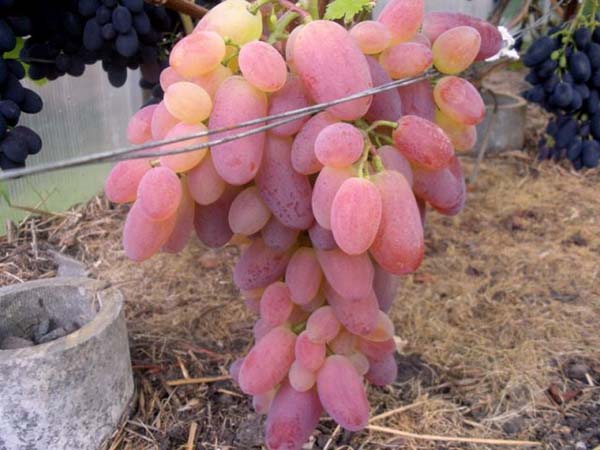
The mass of the berries is 12-18 g, the shape is elongated-oval, the size is 38 by 23 mm. The pulp is characterized by a juicy dense consistency, the peel of the fruit is dense, slightly noticeable when eaten. Excellent taste (harmonious).
By the way! A distinctive feature of the Novocherkassk Jubilee (from the Transfiguration and Victor) is a thinner berry.
Characteristics of the Novocherkassk Yubiley variety:
- ripening period - 110-120 days (early);
- sugar content - 16.8;
- acidity - 5.9 g / l;
- eye load - 30-45;
- pruning vines - for 8-10 buds;
- frost resistance up to -23 degrees.
Advantages:
- Contains bisexual flowers to ensure good pollination in all weather conditions.
- Shoots ripen well.
- No peas.
- Average resistance to fungal diseases (3-3.5 points).
- Transportability is good.
Important! When ripe, the berries quickly lose acidity, so they become completely edible without being completely colored.
Disadvantages:
- Normalization is required (for 1 shoot - no more than 1 bunch).
Julian
The hybrid was bred as a result of crossing Rezamat and Kesha varieties. Amateur selection Kapelyushny V.U.
When grown on its own roots, it forms vigorous bushes.
Differs in large grape clusters of medium friability with an elongated peduncle. The average weight of brushes is 300-500 grams, some are 1-2 kg.
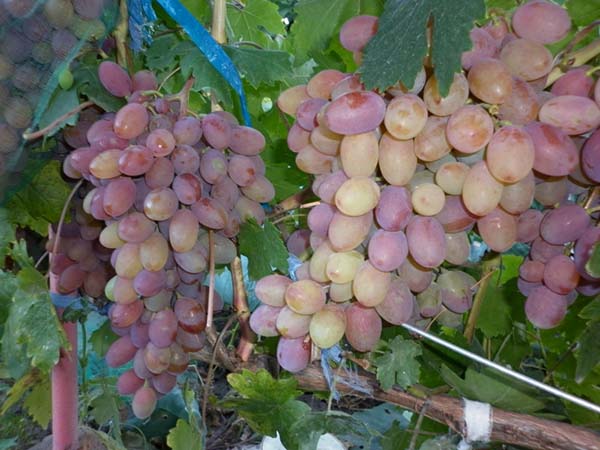
The fruits are very large, 8-12 grams each, the sizes are 40-42 by 26-28 mm, the shape is nipple. Taste qualities are harmonious: simple and sweet (astringency may be present in the taste). The flesh is crispy, with a thin skin that is not noticeable when eating.
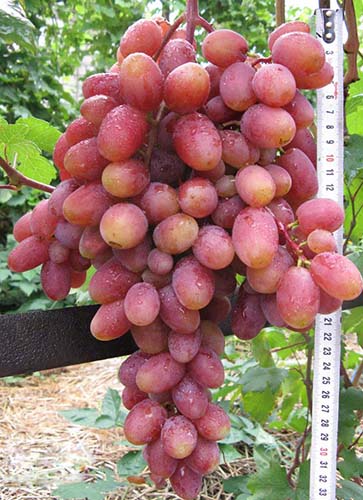
Characteristics of the Julian variety:
- ripening period - 95-105 days (very early);
- the optimal load on the plant is 40-45 eyes;
- the recommended pruning of the vine is 8-10 eyes;
- frost resistance up to -24 degrees.
Important! When grown on a scion, the quality of the fruit increases.
Advantages:
- Julian has bisexual flowers.
- High resistance to major diseases: mildew, oidium, gray rot (2.5-3 points).
- Not damaged by wasps.
- Roots well by cuttings.
- Excellent maturation of shoots.
- High percentage of compatibility with rootstocks.
- Excellent presentation and transportability.
Minuses:
- A load adjustment (standardization) is required.
There is a danger of overfeeding with nitrogen, in which case it will taste like grass ...
Other pink varieties
Also quite popular and good varieties of table rose grapes are:
- Anyuta-2;
- Angelica;
- Ayuta;
- Day;
- Dawn Unsvetaya;
- Kandahar;
- Beauty of the North;
- Pereyaslavskaya Rada;
- Motley;
- Unlight's Gift;
- Rosemus;
- Pink peach;
- Pink Timur;
- Tason.
The best rose varieties of universal and wine grapes
Naturally, among the rose grapes, there are varieties that are also suitable for fresh consumption and wine preparation:
The note! Gurzuf pink and Muscat pink, rather, can be attributed to black (blue) varieties, because they have just a dark red shade of fruits, but it is their names that determine their place in the classification (by color).
Gurzuf pink
A versatile variety.
Obtained by crossing the varieties Muscat VIRa and Magarach 124-66-26. Selections of illegal armed group "Ampelos" (Ukraine).
Vigorous bushes with bisexual flowers.
The clusters at Gurzufsky are cylindrical or cylindrical-conical, winged, medium or large in size, loose, with an average weight of about 250 g.
By the way! The taste is very similar to the Muscat Hamburg variety.
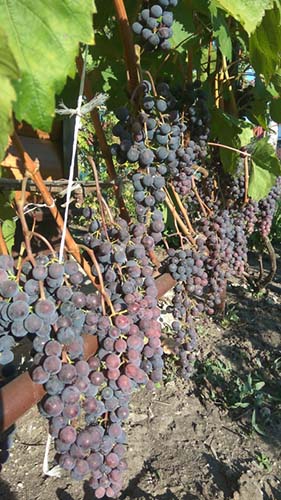
The berries are dark red. The fruits are round in shape, differ in fleshy pulp. The peel of the fruit is dense.The palate is pleasant and harmonious, with a pronounced nutmeg aroma. The number of seeds in fruits is from 3 to 4 pieces.
Recommended for making high quality pink dessert wines.
Characteristics of the variety Gurzufsky pink:
- ripening period - (110-115 days) early;
- yield - 150 g / ha;
- sugar accumulation - 25-29%;
- acidity - 6-7 g / l;
- optimal load - up to 40 eyes;
- recommended pruning of vines - 2-4 eyes;
- frost resistance up to -25 degrees.
Advantages:
- Good tasting score (7.9-8.0 points).
- Field resistance to common diseases (mildew, oidium, gray mold).
- Good maturation of the young vine.
Minuses:
- Relatively weak resistance to phylloxera.
- The overall taste is spoiled by a thick rind that remains in the mouth with a herbaceous taste.
Diana
A versatile variety.
An old variety from North America.
It is characterized by bushes of weak and medium vigor.
Has small whole leaves. The lower part of the leaf plates with a dense edging.
The grape clusters are cylindrical in shape, medium in size and dense in structure.

Rounded small fruits are characterized by slimy pulp with a pronounced isabelle taste.
Characteristics of the Diana variety:
- ripening period - mid to late September;
- frost resistance up to -30 degrees.
Advantages:
- The flowers are bisexual, so there are no problems with the ovary.
- The yield is above average.
- Differs in high resistance to fungal diseases.
- No need to cover for the winter.
Lydia (Isabella pink or red, Lydia pink)
A versatile variety.
Belongs to the isabel group.
It is characterized by a medium to strong growth rate.
Suitable for growing on a personal plot for gardening a gazebo. Also suitable for landscaping balconies, walls of houses.
Leaves can be of different sizes and shapes (three-, five-lobed), slightly dissected, there is a felt edge below.
The clusters are medium (120-200 grams), characterized by a conical or cylindro-conical shape, branching and a loose structure.
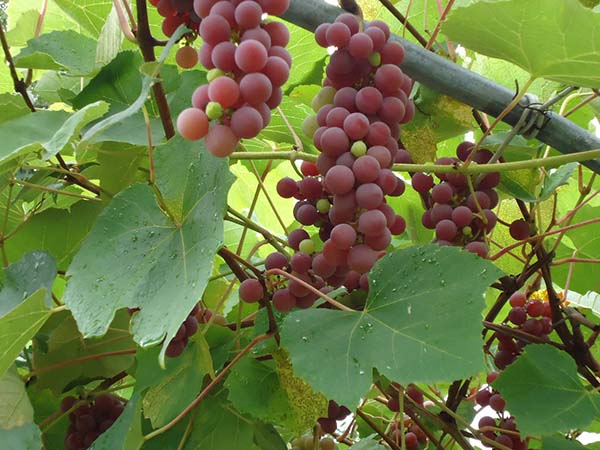
The berries are medium (about 2-3 grams), rounded, dark red, with a lilac wax bloom. The skin is firm, the flesh is slimy, and there is a specific strawberry aroma.
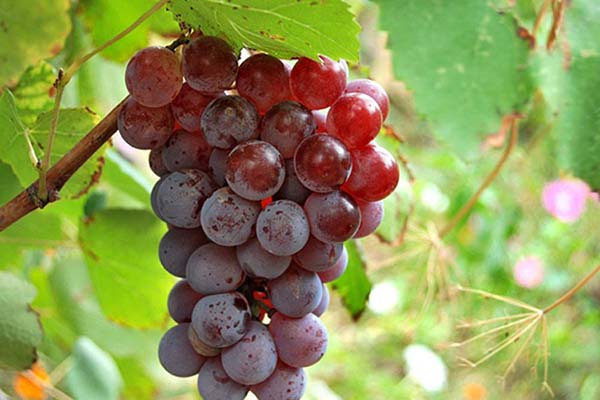
Lydia responds well to fertilization and is not susceptible to waterlogging of the soil.
Characteristics of the Lydia variety:
- ripening period - 140-150 days;
- yield - 100-120 c / ha;
- sugar accumulation - 18-19%;
- acidity level - 5.5-9.3 g / l;
- frost resistance up to -29 degrees.
Important!The variety needs constant pinching and chasing, otherwise the plantings thicken strongly, which somewhat slows down the ripening of fruits, but in general it is very unpretentious.
Benefits:
- Has bisexual flowers.
- Does not need treatment from mildew, oidium, because has field resistance against these diseases.
- One-year-old shoots ripen well.
- Drought tolerant.
- Delivers increased hydration.
- Relatively salt-resistant.
Disadvantages:
- Susceptible to calcareous chlorosis.
- Phyloxera resistance is negligible.
- As the berries ripen, the stalks weaken.
It is used for the preparation of dessert and strong wine materials, as well as juice.
Pink Muscat (Red Muscat, Muscat Rouge de Fronttignan, Moscato Rosso di Madera)
It is a variation of White Muscat. Pure wine variety.
Bushes of medium vigor. The flower is bisexual.
A cluster of medium size (14-18 cm long, 7-10 cm wide), cylindrical or cylindrical-conical, dense. The mass of the bunch is 108-204 g.
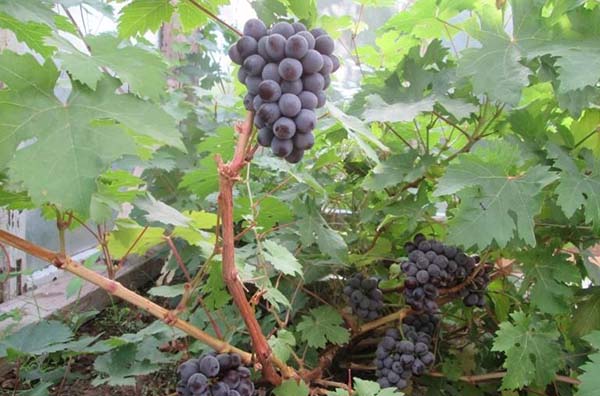
The berry is dark red, covered with a thick waxy bloom, small or medium-sized (11-18 mm long, 10-17 mm wide), round. The skin is thin but firm. The pulp is juicy, tender, with a strong nutmeg aroma. There are 2-4 seeds in the berry.
It is used for the preparation of vintage liqueur Muscat wines South Coast Pink Muscat, Dessert Pink Muscat, Magarach Pink Muscat, which have an original aroma with shades of Kazanlak rose, as well as sparkling wine materials and table wines.
Characteristics of the Muscat pink variety:
- ripening period - 140 days (average);
- yield - 60-80.3 c / ha;
- sugar accumulation - 17.9-24.2 g / 100 ml;
- acidity - 4.8-9.1 g / l;
- frost resistance up to -15-18 degrees.
Advantages:
- Ripening of annual shoots is good or satisfactory.
Less whimsical to soil and climatic conditions than White Muscat. Better adapted to various soil moisture conditions.
Disadvantages:
- Average yield.
- The grape variety is not resistant to mildew, strongly affected by powdery mildew.
- It is damaged by phylloxera and grape leafworm.
- It often cracks and decays.
- Differs in low frost resistance.
Also, among the technical pink grape varieties,
- Oleg (Diamant);
- Rkatsiteli pink;
- Traminer pink (Tramin).
We hope that after reading the article, it will be easier for you to decide which pink grapes are still optimal for planting in your garden or buy on the market to enjoy fresh berries, boil compote, make juice or make rose wine.

